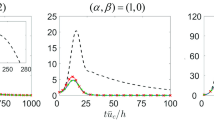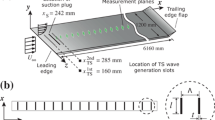Abstract
In recent years there has been an increasing interest in the control of boundary-layer transition through the use of wall suction. In the current work suction is provided through one or more suction panels situated close to the leading edge of a plate. Experiments show that boundary-layer pressure fluctuation measurements can be used to identify the position of transition. Transition can be maintained at a desired location with minimum power consumption by employing an automatic adaptive feedback control loop which regulates the suction flow rates of two independent suction panels. This can be expressed as a constrained optimization problem. To allow the suction flow rates to be updated, a modified least mean squares algorithm is used within the control loop. Experimental measurements show that the control algorithm allows fast and stable convergence towards the optimum suction distribution for a double suction panel configuration. Numerical simulations have also been performed. The two-dimensional boundary layer was calculated allowing the viscous boundary layer to interact with the inviscid outer flow. Following linear stability theory the spatial growth rates are calculated by solving an Orr-Sommerfeld type eigenvalue problem, with the streamwise location of transition predicted via thee N -method. Applying the same optimization strategy as in the experiments, good qualitative agreement between computations and experiments was found. The optimization algorithm has been applied to computer models where the relation between suction flow rates and transition location is described by an empirical analytical function. This shows that the controller can in principle be applied to systems with more than two suction panels.
Similar content being viewed by others
Abbreviations
- b :
-
transition location with zero suction
- d :
-
desired transition location
- e(k):
-
error signal
- k :
-
iteration index
- p :
-
rms pressure
- p ref :
-
reference rms pressure
- r :
-
sum of the reference pressure
- u :
-
streamwise velocity
- u e :
-
external velocity
- \(u_{e_0 } \) :
-
inviscid external velocity
- A :
-
wave amplitude
- F(\(\vec u\)):
-
cost function
- I:
-
identity matrix
- N :
-
maximum amplification factor
- P:
-
projection matrix
- R:
-
Reynolds number
- Re:
-
Reynolds number based on the boundary-layer thickness
- R:
-
matrix of weights
- Tu:
-
turbulence level
- \(\vec u\) :
-
vector of suction flow rates
- v :
-
normal velocity
- v wall :
-
suction velocity at the surface
- x :
-
streamwise coordinates
- x m :
-
microphone location
- x T(k):
-
measured transition location
- y :
-
normal coordinate
- y(k):
-
sum of the measured pressures
- w(k):
-
noise
- \(\tilde L\) :
-
plate length
- α :
-
αr +iα i
- \(\tilde U_\infty \) :
-
free stream velocity
- δ*:
-
displacement thickness
- \(\vec \theta \) :
-
gradient vector
- λ :
-
Lagrange multiplier
- μ :
-
controller gain
- ϕ :
-
disturbance stream function
- φ :
-
disturbance amplitude
- θ :
-
wave frequency
References
Carter, J.E. and Wornom, S.F., Solutions for incompressible separated boundary layers including viscous-inviscid interaction.Aerodynamic Analysis Requiring Advanced Computers NASA SP-347 (1975) 125.
Fortescue, T.R., Kershenbaum, L.S. and Ydstie, B.E., Implementation of self-tuning regulators with variable forgetting factors.Automatica 17 (1981) 831.
Frost, L., An algorithm for linearly constrained adaptive array processing.Proceedings of the IEEE 60 (1972) 926.
Goodwin, G.C. and Sin, K.S.,Adaptive Filtering and Control. Englewood Cliffs: Prentice Hall (1984).
Gad-el-Hak, M., Flow control.Applied Mechanics Review 42 (1989) 261.
Hackenberg, P., Tutty, O.R. and Nelson, P.A., Numerical studies of active control of boundary layer transition. In:Proceedings of the Second Conference on Recent Advances in Active Control of Sound and Vibration. Blacksburg, Virginia, U.S.A. Technoic Publishing Company (1993) p. 636.
Mack, L.M., Boundary-layer linear stability theory.AGARD-Report 709 (1984) 3.1.
Mack, L.M., Transition prediction and linear stability theory.AGARD CP 224 (1977) 1.1.
Malik, M.R., Stability theory for laminar flow control design.Progress in Aeronautics and Astronautics 123 (1990) 3.
Nelson, P.A., Rioual, J.-L. and Fisher, M.J., Experiments on the active control of boundary-layer transition. In:Proceedings of the DGLR-AIAA Conference on Aero-Acoustic. Aachen, Germany. DGLR/AIAA Paper 92-02-010 (1992) p. 56.
Nelson, P.A. and Rioual, J.-L., An algorithm for the automatic control of boundary-layer flow. IVSR Technical Report No. 233, University of Southampton (1994).
Rioual, J.-L., Nelson, P.A., Fisher, M.J. and Dubois, J.-L., Convergence of algorithms for the automatic control of boundary layer transition with a double suction panel. In:Proceedings of the International Congress of Active Control in Mechanical Engineering. Lyon, France (1993).
Rioual, J.-L., Nelson, P.A., Fisher, M.J. and Mullender, A.J., Adaptive boundary layer control with distributed suction. In:Proceedings of the 15th AIAA Aeroacoustics Conference. Long Beach, California, U.S.A. AIAA Paper 93-4346 (1993).
Rioual, J.-L., Nelson, P.A. and Fisher, M.J., Experiments on the automatic control of boundary layer transition.AIAA Journal of Aircraft, Engineering Note (to be published).
Rosen, J.B., The gradient projection method for nonlinear programming. Part 1. Linear constraints.SIAM Journal 8(1) (1960) 181.
Smith, A.M.O., Transition, pressure gradient, and stability theory. In:Proceedings of the 9th International Congress of Applied Mechanics, Vol. 4. Brussels (1956) p. 234.
Van Ingen, J.L., A suggested semi-empirical method for the calculation of the boundary-layer transition region. Report UTH-74, University of Delft (1956).
Veldman, A.E.P., New, quasi-simultaneous method to calculate interacting boundary layers.AIAA Journal 19 (1981). 79.
Wellstead, P.E. and Zarrop, M.B.,Self-Tuning Systems. Chichester: John Wiley (1991).
Author information
Authors and Affiliations
Additional information
= complex wave number
Rights and permissions
About this article
Cite this article
Hackenberg, P., Rioual, JL., Tutty, O.R. et al. The automatic control of boundary-layer transition — Experiments and computation. Appl. Sci. Res. 54, 293–311 (1995). https://doi.org/10.1007/BF00863515
Received:
Accepted:
Issue Date:
DOI: https://doi.org/10.1007/BF00863515




